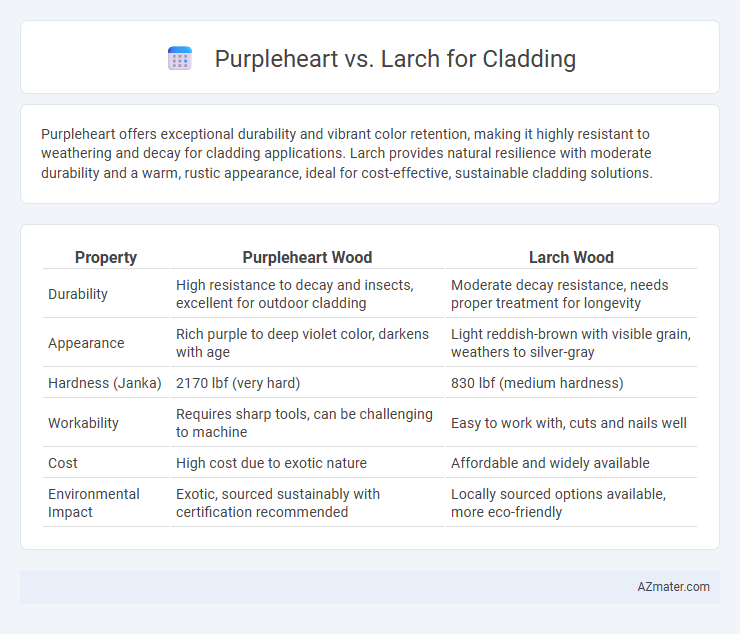Purpleheart offers exceptional durability and vibrant color retention, making it highly resistant to weathering and decay for cladding applications. Larch provides natural resilience with moderate durability and a warm, rustic appearance, ideal for cost-effective, sustainable cladding solutions.
Table of Comparison
| Property | Purpleheart Wood | Larch Wood |
|---|---|---|
| Durability | High resistance to decay and insects, excellent for outdoor cladding | Moderate decay resistance, needs proper treatment for longevity |
| Appearance | Rich purple to deep violet color, darkens with age | Light reddish-brown with visible grain, weathers to silver-gray |
| Hardness (Janka) | 2170 lbf (very hard) | 830 lbf (medium hardness) |
| Workability | Requires sharp tools, can be challenging to machine | Easy to work with, cuts and nails well |
| Cost | High cost due to exotic nature | Affordable and widely available |
| Environmental Impact | Exotic, sourced sustainably with certification recommended | Locally sourced options available, more eco-friendly |
Introduction to Purpleheart and Larch Cladding
Purpleheart cladding is renowned for its striking deep purple hue that intensifies with exposure, offering durability and resistance to rot and insects, making it ideal for exterior applications. Larch cladding features warm golden tones with a distinct grain pattern, prized for its natural weather resistance and strength, commonly sourced from European larch or Siberian larch varieties. Both woods provide excellent options for weatherproof and aesthetically appealing cladding, with Purpleheart standing out for its unique color and Larch for its affordability and sustainability.
Visual Appeal: Comparing Color and Grain
Purpleheart offers a striking visual appeal with its rich, deep purple hue that intensifies over time, creating a unique and exotic look for cladding applications. Larch features a warm, golden-brown color with a distinct, straight grain pattern that provides a more traditional and rustic aesthetic. The contrasting color saturation and grain texture between Purpleheart and Larch make them suitable for different architectural styles, with Purpleheart delivering bold vibrancy and Larch offering subtle elegance.
Durability and Lifespan
Purpleheart wood offers exceptional durability with a natural resistance to decay and insect attacks, making it ideal for long-lasting cladding applications. Larch wood, while moderately durable and resistant to rot due to its high resin content, generally has a shorter lifespan compared to Purpleheart when exposed to harsh weather conditions. Purpleheart cladding can last over 25 years with minimal maintenance, whereas Larch typically provides 15-20 years of effective protection on exterior surfaces.
Weather Resistance Performance
Purpleheart wood boasts exceptional weather resistance due to its dense grain and natural oils, making it highly durable against moisture, rot, and insect damage for cladding applications. Larch is moderately weather-resistant with natural resin content that provides good protection against decay, but it requires regular maintenance and treatment to enhance longevity in harsh weather conditions. Purpleheart outperforms Larch in long-term exposure to wet climates, offering superior stability and reduced risk of warping or cracking.
Maintenance Requirements
Purpleheart wood requires minimal maintenance for cladding due to its natural durability and resistance to decay and insect damage, making it ideal for long-term exterior applications. Larch wood, while moderately durable, needs regular treatments such as sealing or staining to protect against moisture, UV exposure, and fungal growth, increasing upkeep efforts. Choosing Purpleheart reduces the frequency and extent of maintenance, whereas Larch demands consistent attention to preserve its appearance and structural integrity.
Sustainability and Environmental Impact
Purpleheart wood offers exceptional durability and natural resistance to decay, which reduces the need for chemical treatments and frequent replacements in cladding applications. Larch is a fast-growing conifer known for its renewable qualities and lower carbon footprint, making it a sustainable choice for exterior cladding with good weather resistance. Choosing Purpleheart involves higher environmental costs due to slow growth and harvesting impact, whereas Larch supports sustainable forestry practices and carbon sequestration, enhancing its environmental benefits.
Cost and Availability
Purpleheart wood is generally more expensive and less readily available compared to Larch, making it a premium choice for cladding projects with higher budget flexibility. Larch is widely sourced and more affordable, offering good durability and weather resistance at a lower cost, which suits budget-conscious construction. Availability of Larch is more consistent in North America and Europe, whereas Purpleheart, sourced mainly from tropical regions, faces supply limitations and fluctuating prices.
Workability and Installation Complexity
Purpleheart offers moderate workability with its hardness requiring sharp tools and careful handling, whereas Larch is easier to cut and shape due to its softer, fibrous nature. Installation complexity for Purpleheart can be higher because of its density and potential for dulling blades quickly, demanding frequent tool maintenance. Larch's dimensional stability and lighter weight simplify fitting and fastening, making it a preferred choice for less complex cladding projects.
Applications and Design Considerations
Purpleheart offers exceptional durability and vibrant color, making it ideal for decorative cladding in high-end architectural designs where visual impact and weather resistance are crucial. Larch provides a more affordable, naturally rot-resistant option suited for rustic or traditional exterior cladding applications, with a warm, golden hue that weathers to a soft silver-gray. Design considerations include Purpleheart's tendency to darken with exposure and require sealing to maintain color, while Larch's dimensional stability and easier workability make it suitable for a variety of exterior finishes and detailing.
Conclusion: Which Timber is Best for Cladding?
Purpleheart offers exceptional durability and a rich purple hue that deepens over time, making it ideal for visually striking, long-lasting cladding. Larch is naturally resistant to decay, affordable, and weathers to a warm, golden tone, providing excellent value and aesthetic appeal for external siding. For high-end projects prioritizing longevity and unique color, Purpleheart is best, while Larch suits budget-conscious builds seeking reliable performance and traditional timber appearance.

Infographic: Purpleheart vs Larch for Cladding
 azmater.com
azmater.com